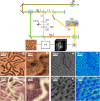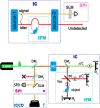Application of quantum imaging in biology
- PMID: 40809988
- PMCID: PMC12339294
- DOI: 10.1364/BOE.566801
Application of quantum imaging in biology
Abstract
Application of quantum imaging in biology In biology, one of the main challenges is achieving a balance between high precision and minimal invasiveness in measurements. With cutting-edge techniques, the primary limitations to experimental accuracy often stem not from device-related noise but from fundamental physical constraints. Since nature is the underlying source of these constraints, it makes sense to go to quantum mechanics, the most basic theory of matter, for a solution. Improved measurement performance may be possible through the application of quantum effects, particularly those pertaining to coherence. It offers useful tools that, at the very least, offer interesting technical solutions even when they don't fully display cohesive behaviors. One of the primary applications of quantum technologies is quantum metrology, which uses the non-classical state of light to measure physical properties with great resolution and sensitivity. For biological applications, the quantum state of light may be utilized for precision enhancement and quantum noise reduction. This explains how quantum metrology, and particularly quantum imaging, can be used to enhance picture quality, measure shifts in quantum scales in biological systems, and boost imaging precision and resolution using quantum light sources, devices, and protocols. In this study, we give a summary of the possible uses of quantum technology in biology and medicine. This review presents a comprehensive overview of how quantum technologies can be applied in biology and medicine. It also explores the latest developments in quantum biological imaging, quantum microscopy, and quantum materials, while discussing the challenges and opportunities these emerging technologies bring.
© 2025 Optica Publishing Group.
Conflict of interest statement
The authors declare no conflicts of interest.
Figures









References
-
- Vernekar S., Xavier J., “Quantum correlation enhanced optical imaging,”
Publication types
LinkOut - more resources
Full Text Sources
